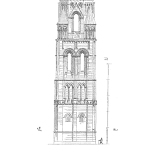
A well-designed maintenance program should eliminate the need to do condition assessments. These assessments are a form of condition monitoring, so why not include them in your proactive maintenance (PM) program? They are carried out to determine the current condition of an asset, determine if any remedial work is required, make an estimate of how long it will last, and forecast timing for eventually replacing the asset. In civil structures like buildings and bridges, these assessments are often called, “inspections”. When timed regularly they are no different from a condition monitoring task in any PM (proactive maintenance) program. Yet, they will be managed differently. Why that is so, doesn’t really matter, but arguably it just adds another program that must be managed in parallel with your maintenance program.
Some inspections are required by regulation and some are not. Inspections are often carried out by “inspectors” who are not generally considered to be a part of your maintenance staff. They might even be contracted – such as engineering firms who inspect bridges. Managing that is no different than contracting equipment condition monitoring, except that you probably don’t use your Maintenance Management System (CMMS or EAM) to do it.
As Asset Management (slowly) becomes “a thing” there is a growing awareness of condition assessments. In the finance world, there is a valid need to forecast future cash flows and financing needs so the forecast of replacement timing is important to them. But that need not be the only use for the assessment. If the assessment is managed as a part of your PM program (albeit with very long task intervals in some cases) it can be useful for more than just that.
In recent RFPs from various government and government-like organizations (utilities), we are seeing calls for condition assessments on all assets. These are driven by finance departments and administrators who are doing their best to comply with emerging asset management requirements (e.g.: it is now law to have asset management plans here in Ontario). However, they may be spending more on this than needed. Why waste the money?
If there is a maintenance program for your physical plant and equipment it should (if well designed) comprise mostly of condition monitoring tasks. If not, then you really need to look into that (yes, we can help). Let’s assume it does though. Why not use that condition monitoring to provide you with the needed “condition assessment” and forecasting?
Most installed equipment and many systems have undergone some form of maintenance throughout their existence. The system may be, say, 40 years old, but replacements of parts of it may actually have served to make it nearly as good as new. It may not need replacement anytime soon, but if you forecast replacement solely on age, you could be planning to spend far more than you need to spend. Your maintainers, the ones who did the work on it for you, would know what condition it is in. If you had captured that information when the work was done you’d already have the information you need to make a decision to keep the system as is and maintain it or to replace it.
Inspections of structures are often not included in maintenance programs. In my opinion that is an oversight on the part of those designing the maintenance programs. Historically, many have opted to use manufacturers’ recommended maintenance. While I disagree with the practice (that’s another topic), more importantly, it will miss the elements of your physical plant that were not “manufactured”. Think of all the stuff like the steel structure holding up the equipment you bought from manufacturers. Your maintenance program probably misses it entirely. Your inspection department (if you have one) might deal with that. If your assets are civil structures and linear assets (roads, rail beds, pipelines) or buildings (parking structures) you may not inspect them regularly at all until problems start to show up. They could all be part of your maintenance program – after all, good maintenance is about sustaining the assets, not fixing them after they break.
It’s quite possible that you are not taking advantage of those areas where you do include condition monitoring in your maintenance program. If you only consider the immediate condition and whether or not action is needed soon, you may not be taking advantage of the knowledge of the condition monitoring crew to tell you about the long-term health of the asset.
Give it some thought. If you want to know the condition and forecast the need for major future work (such as replacement) you may not be capturing that information when it is being learned – during the condition monitoring work. There’s an opportunity for savings and better asset management decision-making, without adding cost. Also, if you manage inspections outside of your maintenance program, then maybe there’s another opportunity to make some savings. Why not use your maintenance management software to trigger those inspections for you?
 Ask a question or send along a comment.
Please login to view and use the contact form.
Ask a question or send along a comment.
Please login to view and use the contact form.
Leave a Reply